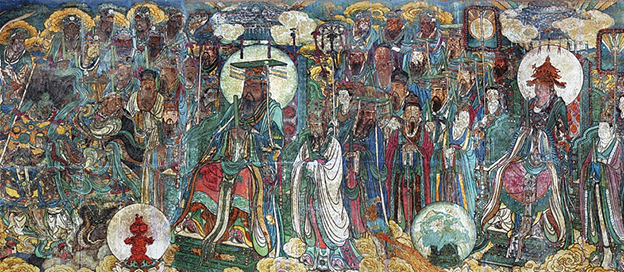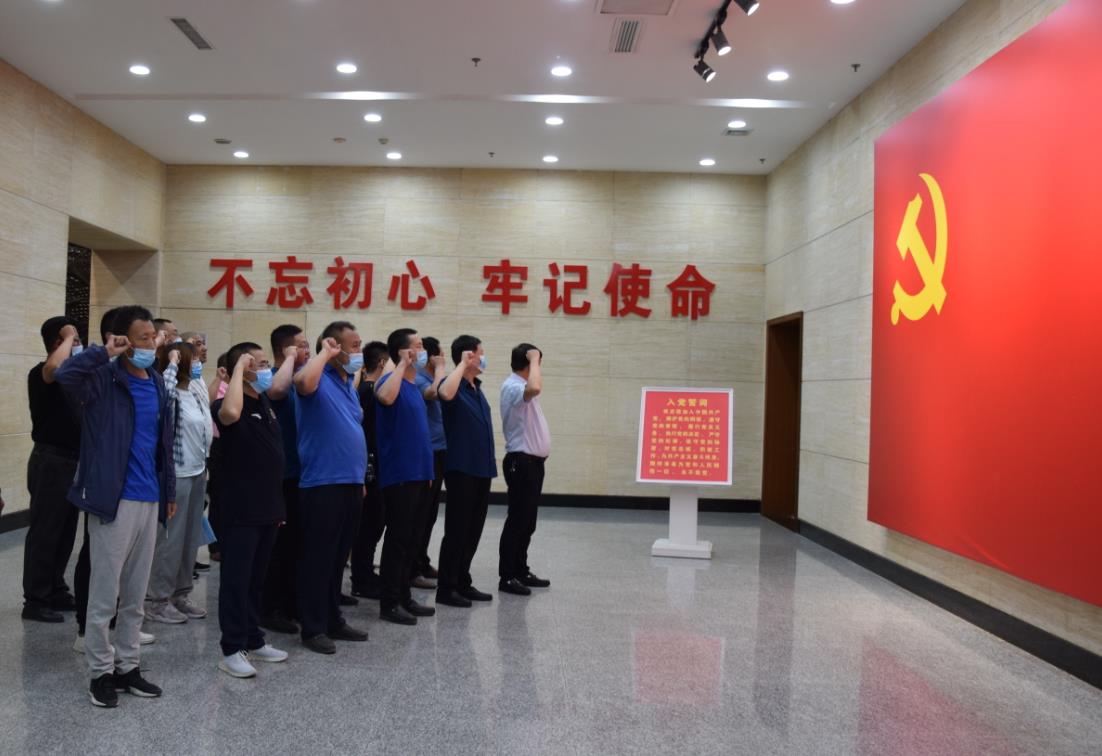
The Painting of Heavenly Court in Yongle Palace is a masterpiece of Chinese Taoist mural art.
Though the Mogao Grottoes in Gansu province gets the lion's share of global attention from tourists and researchers keen on experiencing its vast array of Buddhist cave arts including murals, there is an ancient palace located in Shanxi province that is home to China's largest Taoist complex.
Located in Ruicheng, a county in the southwest of Shanxi province, Yongle Palace is one of the top three Taoist temples in the country, along with Chongyang Palace in Shanxi and Baiyun Guan in Beijing.
Yongle Palace, on which construction started in 1247, was built to worship Lyu Dongbin (born in 796), the founder of the Taoist mainstream Quanzhen Sect. The construction, spanning 110 years during the Mongolian reign in North China and the Yuan Dynasty (1271-1368), included the creation of beautiful Taoist murals.
Murals covering more than 1,005 square meters have been preserved there. Among numerous murals in the palace, the Painting of Heavenly Court-or Chaoyuan Tu in Chinese-is the best known. Measuring 97 meters long and 4.4 meters high, it features 290 Taoist figures.
Art critics and historians have called the Painting of Heavenly Court the greatest mural painting in China.
Experts have said the giant painting is distinguished by its vivid figures, uninterrupted compositions, steady lines and vibrant colors.
They have said the mural's style shows distinctive characteristics of the Yuan Dynasty and is mainly composed of lines, supplemented by renderings of colors and gilded with gold, representative of the skillful and mature techniques of painters during the dynasty. It represents a milestone in the history of ancient Chinese arts.
Weathering winds and rains for more than 700 years, the temple faced severe challenges in the last century.
In 1959, the Chinese government decided to build a huge dam on the Yellow River in the southern part of Shanxi that would flood the site of the Taoist temple. The temple had to be moved and now stands nearly 20 kilometers north of its original location.
Thanks to the painstaking efforts of hundreds of cultural heritage craftsmen and workers, the structures and the murals were kept intact despite the relocation.
Today, the awe-inspiring murals remain a remarkable representative of Taoist arts in the country.
Since the move, local cultural workers have continued efforts to protect the precious heritage site.
In June 2019, when studying the relics moved from their original site, researchers found documents compiled during the period of building the temple. The documents, with records on the history of the Quanzhen Sect of Taoism and the construction of the temple, were entrusted to Nanjing Museum in Jiangsu province for protection, repair and study.
More restoration work was started on the temple in early 2020.
"The restoration will involve cleaning bird droppings, dust and spider webs on the surface, and repairing deeper damage," said Xi Jiulong, head of Shanxi's Yongle Palace mural preservation research institute. "The original style and color of the murals shall be ensured."
The restoration is expected to be completed in three years, Xi said.Province home to biggest Taoist complex in country
2021-03-19 YUAN SHENGGAO
The Painting of Heavenly Court in Yongle Palace is a masterpiece of Chinese Taoist mural art.
Though the Mogao Grottoes in Gansu province gets the lion's share of global attention from tourists and researchers keen on experiencing its vast array of Buddhist cave arts including murals, there is an ancient palace located in Shanxi province that is home to China's largest Taoist complex.
Located in Ruicheng, a county in the southwest of Shanxi province, Yongle Palace is one of the top three Taoist temples in the country, along with Chongyang Palace in Shanxi and Baiyun Guan in Beijing.
Yongle Palace, on which construction started in 1247, was built to worship Lyu Dongbin (born in 796), the founder of the Taoist mainstream Quanzhen Sect. The construction, spanning 110 years during the Mongolian reign in North China and the Yuan Dynasty (1271-1368), included the creation of beautiful Taoist murals.
Murals covering more than 1,005 square meters have been preserved there. Among numerous murals in the palace, the Painting of Heavenly Court-or Chaoyuan Tu in Chinese-is the best known. Measuring 97 meters long and 4.4 meters high, it features 290 Taoist figures.
Art critics and historians have called the Painting of Heavenly Court the greatest mural painting in China.
Experts have said the giant painting is distinguished by its vivid figures, uninterrupted compositions, steady lines and vibrant colors.
They have said the mural's style shows distinctive characteristics of the Yuan Dynasty and is mainly composed of lines, supplemented by renderings of colors and gilded with gold, representative of the skillful and mature techniques of painters during the dynasty. It represents a milestone in the history of ancient Chinese arts.
Weathering winds and rains for more than 700 years, the temple faced severe challenges in the last century.
In 1959, the Chinese government decided to build a huge dam on the Yellow River in the southern part of Shanxi that would flood the site of the Taoist temple. The temple had to be moved and now stands nearly 20 kilometers north of its original location.
Thanks to the painstaking efforts of hundreds of cultural heritage craftsmen and workers, the structures and the murals were kept intact despite the relocation.
Today, the awe-inspiring murals remain a remarkable representative of Taoist arts in the country.
Since the move, local cultural workers have continued efforts to protect the precious heritage site.
In June 2019, when studying the relics moved from their original site, researchers found documents compiled during the period of building the temple. The documents, with records on the history of the Quanzhen Sect of Taoism and the construction of the temple, were entrusted to Nanjing Museum in Jiangsu province for protection, repair and study.
More restoration work was started on the temple in early 2020.
"The restoration will involve cleaning bird droppings, dust and spider webs on the surface, and repairing deeper damage," said Xi Jiulong, head of Shanxi's Yongle Palace mural preservation research institute. "The original style and color of the murals shall be ensured."
The restoration is expected to be completed in three years, Xi said.97 meters long and 4.4 meters high, it features 290 Taoist figures.
Art critics and historians have called the Painting of Heavenly Court the greatest mural painting in China.
Experts have said the giant painting is distinguished by its vivid figures, uninterrupted compositions, steady lines and vibrant colors.
They have said the mural's style shows distinctive characteristics of the Yuan Dynasty and is mainly composed of lines, supplemented by renderings of colors and gilded with gold, representative of the skillful and mature techniques of painters during the dynasty. It represents a milestone in the history of ancient Chinese arts.
Weathering winds and rains for more than 700 years, the temple faced severe challenges in the last century.
In 1959, the Chinese government decided to build a huge dam on the Yellow River in the southern part of Shanxi that would flood the site of the Taoist temple. The temple had to be moved and now stands nearly 20 kilometers north of its original location.
Thanks to the painstaking efforts of hundreds of cultural heritage craftsmen and workers, the structures and the murals were kept intact despite the relocation.
Today, the awe-inspiring murals remain a remarkable representative of Taoist arts in the country.
Since the move, local cultural workers have continued efforts to protect the precious heritage site.
In June 2019, when studying the relics moved from their original site, researchers found documents compiled during the period of building the temple. The documents, with records on the history of the Quanzhen Sect of Taoism and the construction of the temple, were entrusted to Nanjing Museum in Jiangsu province for protection, repair and study.
More restoration work was started on the temple in early 2020.
"The restoration will involve cleaning bird droppings, dust and spider webs on the surface, and repairing deeper damage," said Xi Jiulong, head of Shanxi's Yongle Palace mural preservation research institute. "The original style and color of the murals shall be ensured."
The restoration is expected to be completed in three years, Xi said.
peng ke'er contributed to his story.
By YUAN SHENGGAO
 山西路桥:党建引领 建好“四好农村路”山西路桥建设集团党委扎实开展“党建质量提升年”,实施“六大工程”,立足“十四五”高质量、高速度、高效益发展的战略基点,全面提高党建质量和党建引领发展水平,为打造“国内一流的交通基础设施投资、建设、施工现代化企业集团”提供坚强政治保障。
山西路桥:党建引领 建好“四好农村路”山西路桥建设集团党委扎实开展“党建质量提升年”,实施“六大工程”,立足“十四五”高质量、高速度、高效益发展的战略基点,全面提高党建质量和党建引领发展水平,为打造“国内一流的交通基础设施投资、建设、施工现代化企业集团”提供坚强政治保障。
 常住人口3491万 山西人口普查数据"出炉"山西省统计局向社会通报山西省第七次全国人口普查主要数据。数据显示,山西省常住人口为34915616人,比2010年(第六次全国人口普查数据,下同)减少2.23%,年平均减少0.23%。山西省常住人口总量减少,主要受人口流动变化等因素影响。
常住人口3491万 山西人口普查数据"出炉"山西省统计局向社会通报山西省第七次全国人口普查主要数据。数据显示,山西省常住人口为34915616人,比2010年(第六次全国人口普查数据,下同)减少2.23%,年平均减少0.23%。山西省常住人口总量减少,主要受人口流动变化等因素影响。